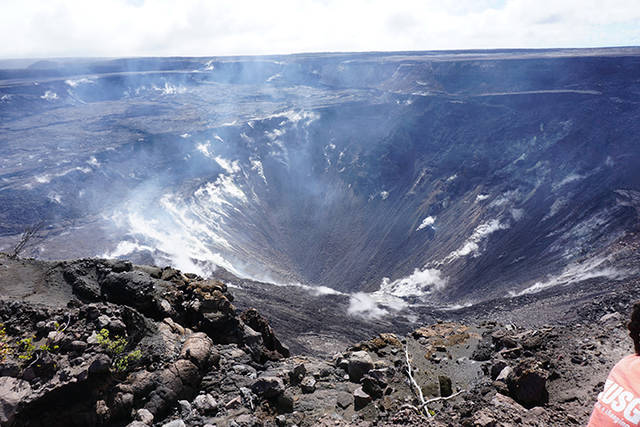USGS lowers Kilauea Volcano alert level back to normal

COURTESY USGS
View into Halemaumau from the west rim of Kilauea’s summit caldera on March 3.
The U.S. Geological Survey has moved Kilauea Volcano’s alert level back to normal, signifying an end to one of the most voluminous eruptions in Hawaii island history.
The USGS Hawaiian Volcano Observatory on Tuesday afternoon moved the alert level for ground-based hazards from advisory to normal Opens in a new tab after data from the past eight months have shown relatively low rates of seismicity, deformation and gas emission at the summit and East Rift Zone. The aviation color code was also lowered from yellow to green.
Puna residents can breathe a sigh of relief, with consistent weeks of low sulfur dioxide emission rates from the summit as well as Puu Oo.
The eruption at Puu Oo marked its seven-month anniversary of no surface activity at the middle East Rift Zone in December, which scientists said “could be considered over.” Opens in a new tab A recent overflight of the crater showed that its shape has been altered by small rockfalls within it, but no major changes were observed.
Scientists said low rates of activity have also been detected in the Lower East Rift Zone, including Leilani Estates, the area where the eruption began in May 2018.
“Kilauea Volcano has maintained a low level of non-eruptive unrest since the end of the lower East Rift Zone eruption and summit collapse in early September 2018,” the USGS said on Tuesday. “The past nearly eight months without active lava at the surface of the volcano marks the longest time interval without eruption since the 17-month period between November 1979 and April 1982.”
Don't miss out on what's happening!
Stay in touch with breaking news, as it happens, conveniently in your email inbox. It's FREE!
The USGS also said based on history, most likely, that the next eruption of Kilauea would take place within a few years, in the caldera, and in a decade or longer, on one of the volcano’s rift zones.
“This prognosis assumes a return to Kilauea’s general style of behavior for the past 200 years,” the USGS said.
Various views of the dramatic changes to Kilauea caldera and Halemaumau overlook from HVO’s observation towers are available via webcams Opens in a new tab.
Under the USGS’s national alert notification system, a normal level means that a volcano is in its typical background, non-eruptive state, or, after change from a higher level, volcanic activity has ceased and the volcano has returned to a non-eruptive background state.
There are four levels total, ranging from normal to advisory, watch and warning. At the advisory level, which Kilauea was at for the past eight months, a volcano is exhibiting signs of elevated unrest above known background levels, or it has decreased significantly after change from a higher level, but continues to be closely monitored for possible, renewed increase.
At the warning level, a hazardous eruption is imminent, underway or suspected.
Scientists noted that a GPS station on the north flank of Puu Oo has been showing steady slumping, or inward sloughing off, of the crater’s edge. They believe, however, that the motion is caused by the unstable edge of the cone rather than a direct relation to magmatic activity.
“Despite this change, Kilauea remains an active volcano, and it will erupt again,” said the USGS in its weekly update on Tuesday. “Although we expect clear signs prior to a return to eruption, the time frame of warning may be short. Island of Hawaii residents should be familiar with the long-term hazard map for Kilauea Volcano and how to stay informed about Kilauea activity.”



